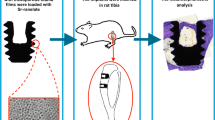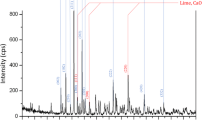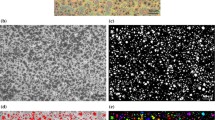Abstract
This study proves that a film of Strontianite (SrCO3) successfully can be formed on a bioactive surface of sodium titanate when exposed to a strontium acetate solution. This Strontianite film is believed to enable local release of strontium ions from implant surfaces and thus stimulate bone formation in vivo. Depending on the method, different types of films were achieved with different release rates of strontium ions, and the results points at the possibility to tailor the rate and amount of strontium that is to be released from the surface. Strontium has earlier been shown to be highly involved in the formation of new bone as it stimulates the replication of osteoblasts and decreases the activity of osteoclasts. The benefit of strontium has for example been proved in studies where the number of vertebral compression fractures in osteoporotic persons was drastically reduced in patients receiving therapeutical doses of strontium. Therefore, it is here suggested that the bone healing process around an implant may be improved if strontium is administered locally at the site of the implant. The films described in this paper were produced by a simple immersion process where alkali treated titanium was exposed to an aqueous solution containing strontium acetate. By heating the samples at different times during the process, different release rates of strontium ions were achieved when the samples were exposed to simulated body fluid. The strontium containing films also promoted precipitation of bone like apatite when exposed to a simulated body fluid.




Similar content being viewed by others
References
Canalis E, et al. The divalent strontium salt S12911 enhances bone cell replication and bone formation in vitro. Bone. 1996;18:517–23.
Marie PJ, et al. Mechanisms of action and therapeutic potential of strontium in bone. Calcif Tissue Int. 2001;69:121–9.
Meunier PJ, et al. The effects of strontium ranelate on the risk of vertebral fracture in women with postmenopausal osteoporosis. N Engl J Med. 2004;350:459–68.
Ammann P. Strontium ranelate: a novel mode of action leading to renewed bone quality. Osteoporos Int. 2005;16:11–5.
Xue WC, et al. Preparation and cell-materials interactions of plasma sprayed strontium-containing hydroxyapatite coating. Surf Coating Tech. 2007;201:4685–93.
Capuccini C, et al. Strontium-substituted hydroxyapatite coatings synthesized by pulsed-laser deposition: in vitro osteoblast and osteoclast response. Acta Biomater. 2008;4:1885–93.
Nan KH, et al. Strontium doped hydroxyapatite film formed by micro-arc oxidation. Mater Sci Eng C Biomim Supramol Syst. 2009;29:1554–8.
Ni GX, et al. Strontium-containing hydroxyapatite (Sr-HA) bioactive cement for primary hip replacement: an in vivo study. J Biomed Mater Res B Appl Biomater. 2006;77B:409–15.
Hyup Lee J, et al. Biomechanical and histomorphometric study on the bone-screw interface of bioactive ceramic-coated titanium screws. Biomaterials. 2005;26:3249–57.
Nishiguchi S, et al. The effect of heat treatment on bone-bonding ability of alkali-treated titanium. Biomaterials. 1999;20:491–500.
Liang B, et al. Histological and mechanical investigation of the bone-bonding ability of anodically oxidized titanium in rabbits. Biomaterials. 2003;24:4959–66.
Fujibayashi S, et al. Bioactive titanium: effect of sodium removal on the bone-bonding ability of bioactive titanium prepared by alkali and heat treatment. J Biomed Mater Res. 2001;56:562–70.
Lu X, Leng Y. Theoretical analysis of calcium phosphate precipitation in simulated body fluid. Biomaterials. 2005;26:1097–108.
Ohgushi H, Caplan AI. Stem cell technology and bioceramics: from cell to gene engineering. J Biomed Mater Res. 1999;48:913–27.
Oguchi H, et al. Long-term histological-evaluation of hydroxyapatite ceramics in humans. Biomaterials. 1995;16:33–8.
Best SM, et al. Bioceramics: past, present and for the future. J Eur Ceram Soc. 2008;28:1319–27.
Yang BC, et al. Preparation of bioactive titanium metal via anodic oxidation treatment. Biomaterials. 2004;25:1003–10.
Hench LL. The story of Bioglass (R). J Mater Sci Mater Med. 2006;17:967–78.
Jonasova L, et al. Biomimetic apatite formation on chemically treated titanium. Biomaterials. 2004;25:1187–94.
Jaffe WL, Scott DF. Total hip arthroplasty with hydroxyapatite-coated prostheses. J Bone Joint Surg Am. 1996;78A:1918–34.
Landor I, et al. Hydroxyapatite porous coating and the osteointegration of the total hip replacement. Arch Orthop Trauma Surg. 2007;127:81–9.
Morris HF, Ochi S. Hydroxyapatite-coated implants: a case for their use. J Oral Maxillofac Surg. 1998;56:1303–11.
Kim HM, et al. Preparation of bioactive Ti and its alloys via simple chemical surface treatment. J Biomed Mater Res. 1996;32:409–17.
Svetina M, et al. Deposition of calcium ions on rutile (110): a first-principles investigation. Acta Mater. 2001;49:2169–77.
Forsgren J, et al. Formation and adhesion of biomimetic hydroxyapatite deposited on titanium substrates. Acta Biomater. 2007;3:980–4.
Kokubo T, Takadama H. How useful is SBF in predicting in vivo bone bioactivity? Biomaterials. 2006;27:2907–15.
LeGeros RZ. Properties of osteoconductive biomaterials: calcium phosphates. Clin Orthop Relat Res. 2002;81–98.
Clarkin O, et al. Strontium-based glass polyalkenoate cements for luting applications in the skeleton. J Biomater Appl. 2008, published online. doi: 10.1177/0885328208099085. Accessed 12 Dec 2008.
Author information
Authors and Affiliations
Corresponding author
Rights and permissions
About this article
Cite this article
Forsgren, J., Engqvist, H. A novel method for local administration of strontium from implant surfaces. J Mater Sci: Mater Med 21, 1605–1609 (2010). https://doi.org/10.1007/s10856-010-4022-8
Received:
Accepted:
Published:
Issue Date:
DOI: https://doi.org/10.1007/s10856-010-4022-8




